SUBFAMILY MYRMICINAE - Genus Crematogaster with key to subgenera
| The Ants of
Africa SUBFAMILY MYRMICINAE - Genus Crematogaster with key to subgenera |
|
| Contents - Myrmicinae - MYRMICINAE Introduction |
In Tribe CREMATOGASTRINI. This major Tribe is in great need of extensive revision, and Belshaw & Bolton (1994b) remarked that no synthesizing taxonomic studies had been undertaken.
Diagnostic features - Mandibles with four or five teeth. Antennae 10- or 11-segmented. Eyes present, usually well developed, set at or just behind the mid-length of the head. Promesonotal suture usually a weak impression. Metanotal groove impressed, often deeply so. Propodeum usually armed with a pair of spines or teeth, rarely these are reduced to tubercles or are absent. Petiole dorsoventrally flattened, without a node, the dorsal surface weakly convex to concave. Postpetiole a node, often with a median longitudinal groove, attached to the dorsum of the first gastral segment. Gaster heart-shaped or triangular in dorsal view. Sting spatulate. Tarsal claws simple, often large.
Lund's (1831a) genus description, based on specimens he observed in
Brazil, is at ![]() . Although Lund's
spelling was printed clearly many authors over the next 60 years or so
used Cremastogaster.
. Although Lund's
spelling was printed clearly many authors over the next 60 years or so
used Cremastogaster.
The mode of attachment of the postpetiole to the gaster allows the very characteristic defence posture in which the gaster is turned forwards over the alitrunk. Many members may have economic importance, especially as several species are among the dozen or so dominant ants which effectively determine much of the insect fauna of cocoa and other trees. Bernard (1952) described them as omnivores and very active, adding that genus members were the only ants which victoriously resist raids by nomadic Dorylus army ants.
A very large genus with considerable taxonomic confusion. Bernard (1952) wrote of the Crematogastrini, with its single genus Crematogaster as the most intricate and difficult to classify of all the tropical ants. Even W.M. Wheeler, probably the most familiar with the ant fauna of the globe, had left it to Santschi to catalogue the Crematogaster of the Congo. The evidence from Santschi's collection showed also that he was full of uncertainty over the genus. Nevertheless, Bernard noted that 136 species had been described from the continent, with 74 known from French West Africa and the Congo. In itself this number was not terrifying, indeed it was surpassed by Camponotus but they were manageable in taxonomic terms. The problem with Crematogaster, however, was the extreme variability of workers from one nest to the next. For example, he had studied the species Crem. aďrensis inhabiting Tamarisk trees growing at a small oasis in the Fezzân area of Algeria. Within that tiny location the ants changed significantly from one tree to another in colour and sculpturation so much as to lead one to doubt their common identity. If such variation could be observed there, then what problems might one find in tackling the diversity of forms in the tropical forest? This was not helped by the relatively few specimens collected at any one locality by most expeditions to Africa. Thus, he concluded that the number of named forms was almost certainly overinflated and revision, especially on the basis of males and queens, was needed.
For subgenera I have followed the subgeneric separation given in Wheeler (1922, pp 661-662, which had been derived from a paper by Santschi (1918d), who had considerably helped Wheeler in separating out the Congo Expedition species. Bolton (1994, 1995) has listed the subgenera Atopogyne Forel, Crematogaster Lund, Decacrema Forel, Orthocrema Santschi and Sphaerocrema Santschi as still valid.
Bolton prepared a key to those ants he encountered in West Africa. This unpublished list, which I came across at CRIN in 1974, contained 25 species, many of which I neither found in the CRIN museum nor collected in my surveys. However, I found a number of species which were not on that list. When searching the catalogue of Bolton (1995), it should be noted that references to the subgenus Acrocoelia mostly indicate species included in the subgenus Crematogaster.
Collections and reports from elsewhere, notably in Ghana, also have many species denoted only by code numbers, and even Belshaw & Bolton (1994b) did not have subgenus separations. Collingwood (1967-68) attempted to clarify the then situation of confusion over the identities of Crematogaster depressa and other closely related species most notably suggesting that earlier reports of C. depressa may well have concerned Crematogaster clariventris. Bolton (1970-71) made a further attempt to provide a key to separate the six species whcih were the most common carton-nest builders at CRIG - C. africana, C. buchneri, C. clariventris, C. depressa and C. jullieni of the subgenus Atopogyne, and C. stadelmanni, which he described as the only local species in the subgenus Nematocrema. Because the queens did not conform to the original Forel characteristics of the subgenus, he remained unsure if buchneri and clariventris were indeed in the subgenus, but had them there in his new catalogue (Bolton, 1995). It should be noted that Bolton's (1970-71) remarks must cast doubt on the several other references (including Strickland, 1951a) to C. striatula being the commonest species at CRIG (see the species notes).
Radoszkowsky (1881) listed Crematogaster nitidus F Smith, from Angola, collected by Welwitsch. Bolton (1995: 158) has this as a nomen nudum.
Key to subgenera (derived from Santschi in Wheeler, 1922), as applied to West Africa and with the proviso that inaccuracies are quite possible in the absence of any modern revisionary work, plus what Bolton (1995) indicates (a list of species and forms is given below):
Note (2015): Blainer (2012) investigated Oxygyne from Madagascar and some African species, and felt that Nematocrema, sole species stadelmanni, was best synonymised under Oxygyne. See the latter subgenus page.
| 1 | 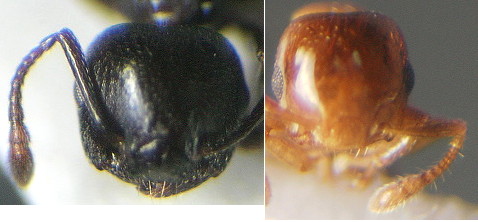 Antenna
10-jointed; club 2-or 3-segmented Antenna
10-jointed; club 2-or 3-segmented |
subgenus Decacrema |
| -- | Antenna 11-jointed | 2 |
| 2 | 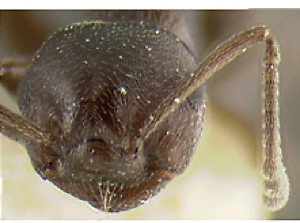 Frontal carinae short (condylar bulbs
exposed, at least in Oxygyne) Frontal carinae short (condylar bulbs
exposed, at least in Oxygyne) |
3 |
| -- | 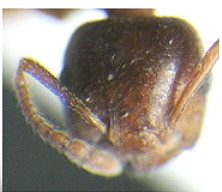 Frontal
carinae well developed Frontal
carinae well developed |
4 |
| 3 | 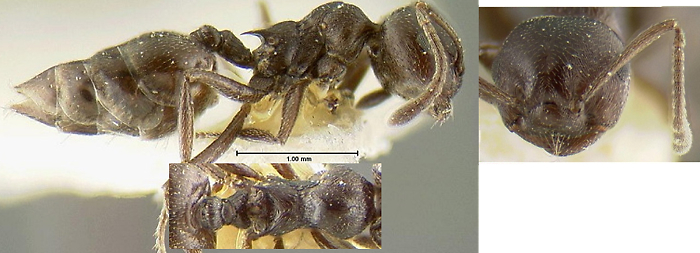 Antennal club 3-jointed Antennal club 3-jointed |
subgenus Oxygyne |
| -- | 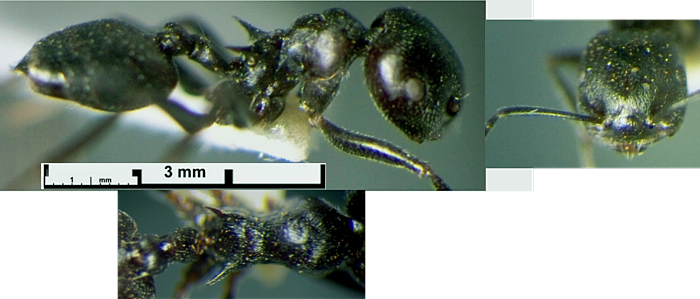 Antennal club of more than 3 joints, post-petiole narrow Antennal club of more than 3 joints, post-petiole narrow |
subgenus Nematocrema |
| 4 |  Petiole
with parallel sides, usually straight
or arcuate, rarely broader posteriorly, antennal club 2-jointed Petiole
with parallel sides, usually straight
or arcuate, rarely broader posteriorly, antennal club 2-jointed |
subgenus Orthocrema |
| -- | Petiole broadened in front, trapezoidal, sometimes truncated or rounded at anterior angles, sometimes oval | 5 |
| 5 |
 Postpetiole entire, without a median furrow; petiole usually with an anterior, ventral tooth Postpetiole entire, without a median furrow; petiole usually with an anterior, ventral tooth |
subgenus Sphaerocrema |
| -- | 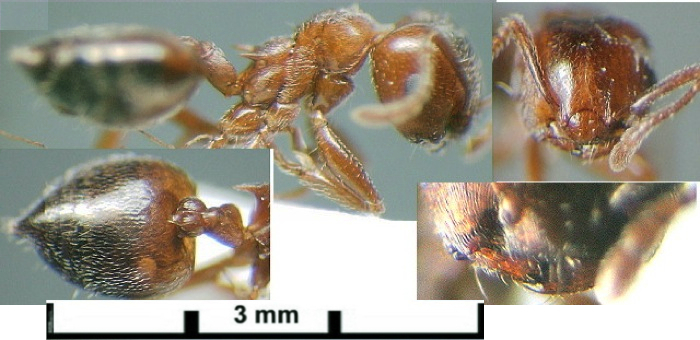 Postpetiole dorsum grooved or posteriorly
impressed; with the latter often the petiole is ovoid not trapezoidal
when seen from above Postpetiole dorsum grooved or posteriorly
impressed; with the latter often the petiole is ovoid not trapezoidal
when seen from above |
subgenus Crematogaster sensu stricto |
| -- | 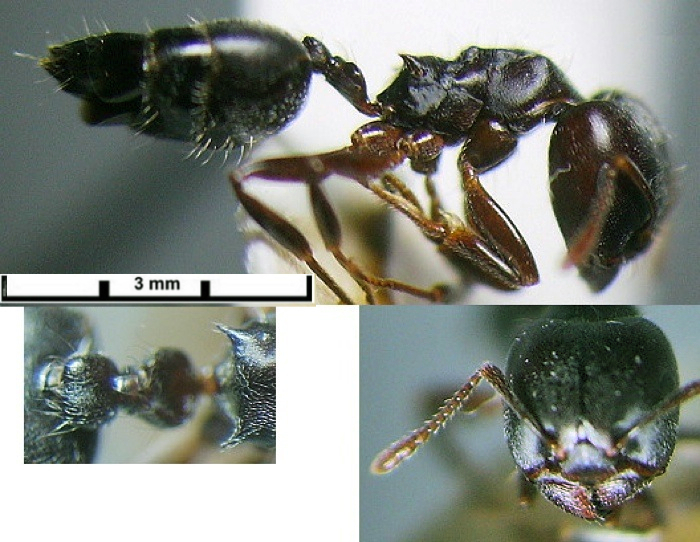 Postpetiole
merely
impressed behind, promesonotal suture
impressed, mesonotum carinate in front, propodeal spines often curved
downwards; petiole usually with a narrow, flat profile and without an
anterior ventral tooth; basic sculpture mostly densely striate Postpetiole
merely
impressed behind, promesonotal suture
impressed, mesonotum carinate in front, propodeal spines often curved
downwards; petiole usually with a narrow, flat profile and without an
anterior ventral tooth; basic sculpture mostly densely striate |
subgenus Atopogyne |
Note: There is also a number of forms which I could not safely place in any of the subgenera and these are listed in the subsection Undetermined forms.
| MYRMICINAE Introduction |
© 2007, 2008, 2010, 2013, 2015, 2016 - Brian Taylor CBiol
FRSB FRES 11, Grazingfield, Wilford, Nottingham, NG11 7FN, U.K. |
href="crematogaster.htm"